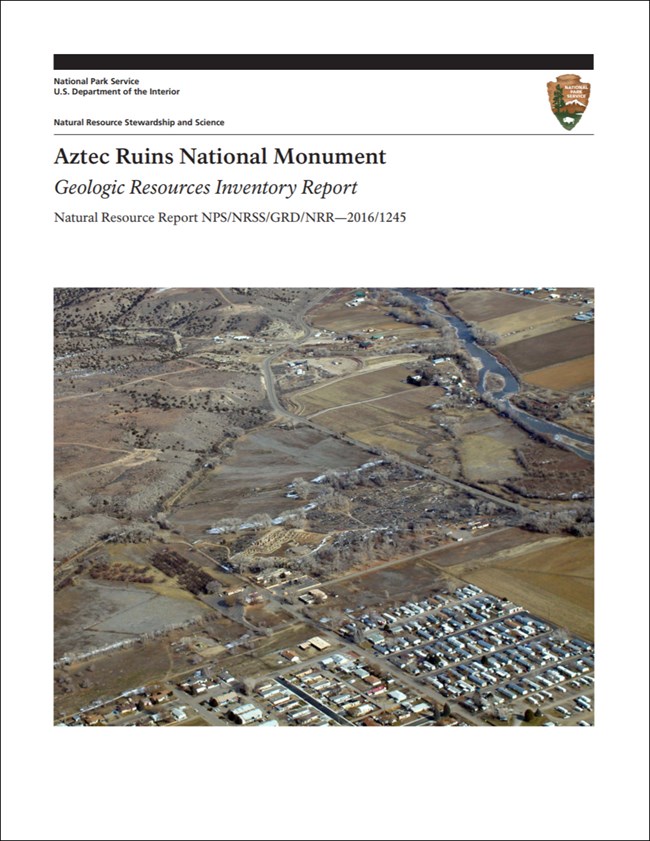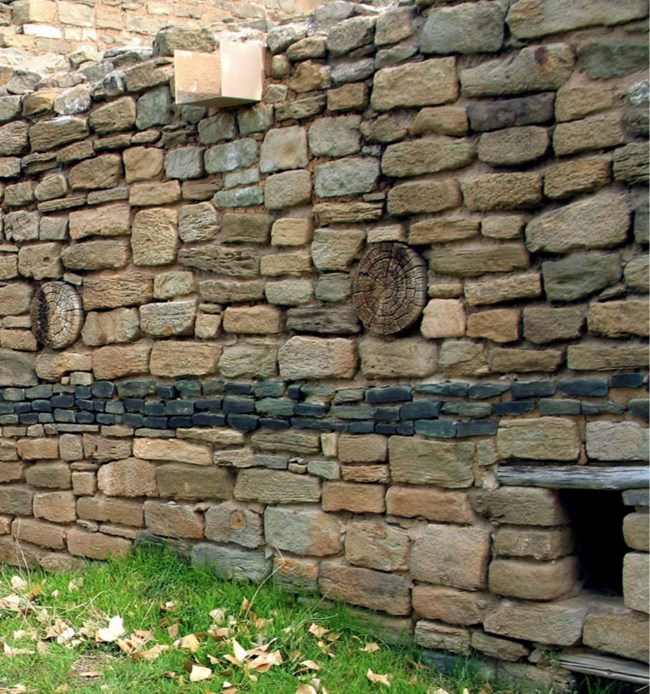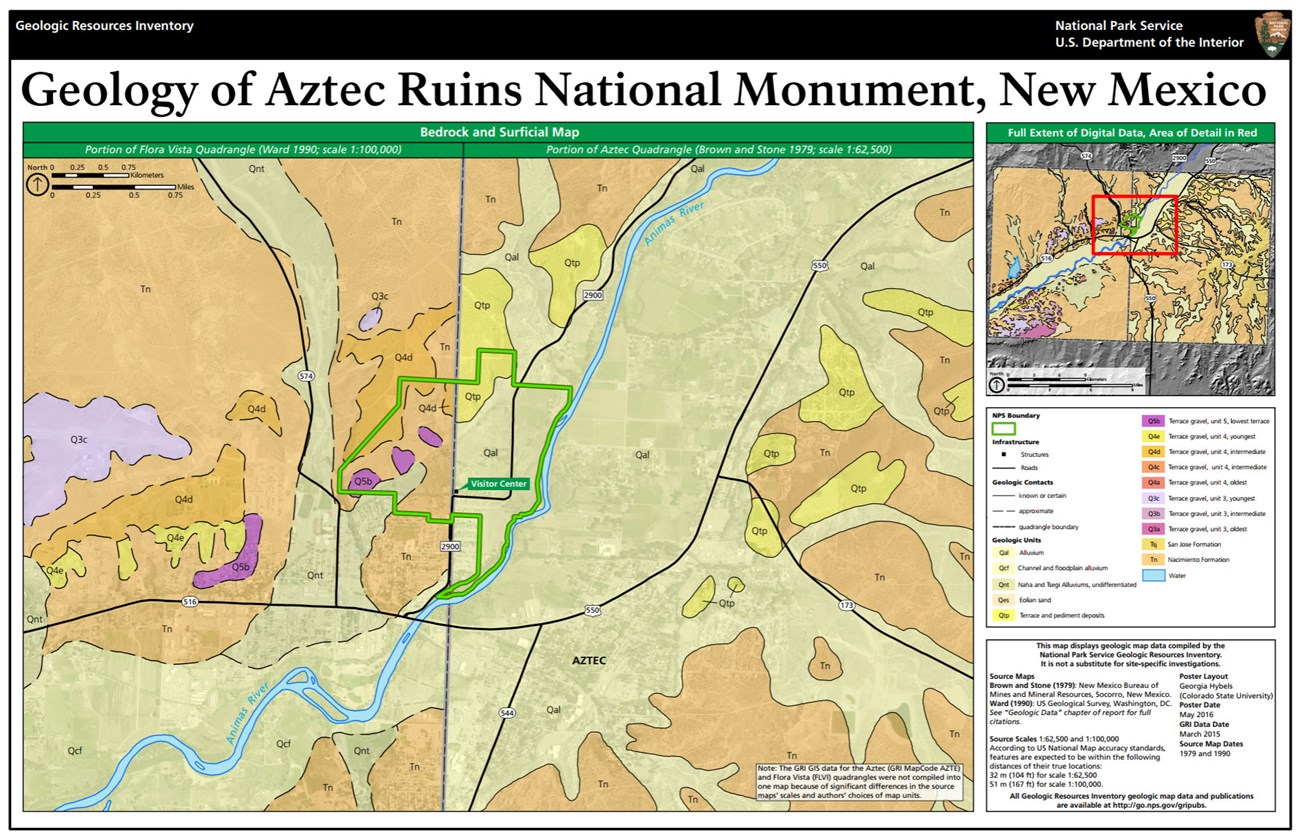Last updated: June 17, 2024
Article
NPS Geodiversity Atlas—Aztec Ruins National Monument, New Mexico
Geodiversity refers to the full variety of natural geologic (rocks, minerals, sediments, fossils, landforms, and physical processes) and soil resources and processes that occur in the park. A product of the Geologic Resources Inventory, the NPS Geodiversity Atlas delivers information in support of education, Geoconservation, and integrated management of living (biotic) and non-living (abiotic) components of the ecosystem.

Geologic Features and Processes
Aztec Ruins National Monument preserves an outstanding example of an ancestral Puebloan farming community, including a complex of public structures and ceremonial buildings. Aztec Indians never lived here; rather ancestral Puebloans inhabited this site for about two centuries (ca. AD 1100–1130). After various changes to boundaries since its proclamation in 1923, Aztec Ruins National Monument now encompasses 318 acres (129 ha) within the City of Aztec, New Mexico. As stated in the park brochure, “By the time building ceased in the late 1200s, the complex consisted of several great houses, tri-walled kivas, small residential pueblos, earthworks, roads, and great kivas. Far from being an uncontrolled urban sprawl, the formal layout of the settlement, purposeful landscape modifications, and the orientation and visual relationships among the buildings all indicate a grand design.” Located between two major centers—Chaco Canyon to the south and Mesa Verde to the north—Aztec was one of the largest ancestral Puebloan settlements in the Southwest (Thybony, 1992).
River Systems and Fluvial Landforms
The ancestral Puebloans took advantage of the perennial waters of the Animas River, which runs along the eastern boundary of the national monument. Many modern Puebloan people know this site as the “Place by Flowing Waters,” though other names exist. The Animas River flows from the San Juan Mountains through the San Juan Basin, crossing varied rock types before joining the San Juan River near Farmington, New Mexico. The landscape through which the river travels is reflected in the variety of rock types and grain sizes in the alluvium deposited in the national monument. Much of this alluvial material, which ranges in size from cobbles and gravels to unconsolidated sand, was used in construction at Aztec Ruins.
Glacial Outwash
Aztec Ruins National Monument is located in the Animas River valley, which is significant as the former site of the largest glacier bordering the Colorado Plateau (Gillam, 1998). The Animas Glacier was one of several valley glaciers that issued from a small ice field in the San Juan Mountains. Aztec Ruins lies on outwash of this glacier, which may have been reworked during interglacial times. Middle and late Pleistocene glacial end moraines occur at Durango, Colorado, and river terraces of Holocene to late Miocene (?) age are preserved in places for 50 miles (80 km) from Durango south to Farmington (Gillam, 1998). Three groups of moraines, ranging in age from approximately 15,000 to 360,000 years old, are differentiated by increasing distance down valley, heights above river level, and later modification (e.g., soil development) (Gillam, 1998).
Downcutting and Incision History
The ancestral Animas River was probably established after the Laramide Orogeny—a mountain-building event that began about 70 million years ago—perhaps as late as Miocene time. Therefore, downcutting of the Animas River valley began before glaciation, but probably after the end of mid-Tertiary volcanism in the San Juan Mountains; that is, between 18- and 3 million years ago. Regional relief also results in part from the earlier Laramide uplift. In the Animas River valley, continuing incision may be a result of isostatic compensation of landscape denudation, tectonically caused base-level fall, and headward erosion that followed stream captures that occurred farther downstream along the Colorado River. Short-term changes in the river’s incision rate, caused by glacial-interglacial climatic cycles, account for the formation of terraces. Terrace ages and early river diversions suggest that incision has accelerated toward the present (Gillam, 1998).
River Terraces
Changes in channel gradient, discharge, or sediment load can lead to a river channel incising (downcutting) into its floodplain. As a result, the former floodplain is abandoned and left as a relatively flat surface (terrace), which is separated from the new floodplain below. Terraces can form in the alluvial fill of river valleys or be cut into bedrock (i.e., strath terraces).
Investigators have identified roughly 34 existing terrace levels in the Animas valley between Durango and Farmington; three strath terraces occur in Aztec Ruins National Monument. These flat alluvial surfaces step up in elevation from the modern floodplain (Holocene Epoch) to old, “stranded” floodplains as high as 2,165 feet (660 m) above the valley floor. In most places, younger alluvial fan deposits and eolian loess overlie the terrace alluvium. Gillam (1998) used the Lava Creek B ash (~640,000 years old) from a Yellowstone ash-fall event and regional correlations to estimate ages for each terrace level.
Geologically speaking, terraces are significant because they record entire glacial-interglacial cycles and can be well preserved, though the oldest terraces in this area may be unrelated to glaciations. In contrast, end moraines record only the maximum or near-maximum extent of the glacier, and older ones are often destroyed during younger ice advances.
Aeolian (Dunes) Landforms
Modern aeolian processes (e.g., wind erosion of the ruins) are not a management concern. However, deposits of Quaternary loess (windblown dust) occur within the monument. These deposits, which may be as thick as 3 feet (0.9 m), have cultural significance: ancestral Puebloans dug subsurface structures into the loess and made mortar from it (Paul Carrara, U.S. Geological Survey, personal communication, March 8, 2007). The clay content of the loess retains moisture, which was significant for prehistoric farming in the region.
Paleontological Resources
A single bedrock outcrop of the Nacimiento Formation occurs in the monument. This formation is known to have vertebrate fossils and petrified wood at other locales. With so few rock outcrops in the monument, however, the likelihood of in situ vertebrate fossils being discovered at Aztec Ruins is slim. Pieces of petrified wood may be found in terrace gravels, however.
Fossils have been recovered and cataloged in the park's museum collection during archeological work at the monument. Currently there is no evidence that these fossils came from geological formations within the monument. Prehistoric people may have collected the fossil material from neighboring areas. Fossils found in cultural resource contexts, such as necklaces and projectile points, are known from a number of parks and throughout the NPS.
All NPS fossil resources are protected under the Paleontological Resources Preservation Act of 2009 (Public Law 111-11, Title VI, Subtitle D; 16 U.S.C. §§ 470aaa - 470aaa-11).
Regional Geology
Aztec Ruins is a part of the Colorado Plateaus Physiographic Province and shares its geologic history and some characteristic geologic formations with a region that extends well beyond park boundaries.
- Scoping summaries are records of scoping meetings where NPS staff and local geologists determined the park’s geologic mapping plan and what content should be included in the report.
- Digital geologic maps include files for viewing in GIS software, a guide to using the data, and a document with ancillary map information. Newer products also include data viewable in Google Earth and online map services.
- Reports use the maps to discuss the park’s setting and significance, notable geologic features and processes, geologic resource management issues, and geologic history.
- Posters are a static view of the GIS data in PDF format. Newer posters include aerial imagery or shaded relief and other park information. They are also included with the reports.
- Projects list basic information about the program and all products available for a park.
Source: NPS DataStore Saved Search 2712. To search for additional information, visit the NPS DataStore.
A NPS Soil Resources Inventory project has been completed for Aztec Ruins National Monument and can be found on the NPS Data Store.
Source: NPS DataStore Saved Search 2702. To search for additional information, visit the NPS DataStore.

Related Links

